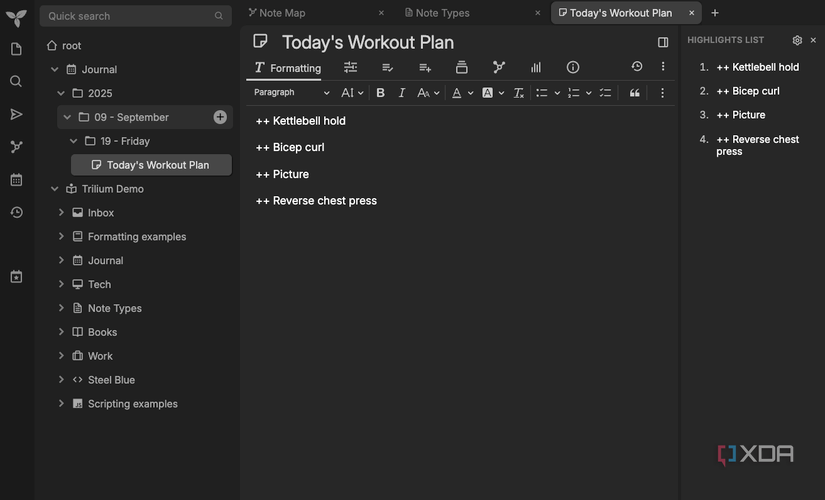Dhruv Bhutani has been writing about consumer technology since 2008, offering deep insights into the personal technology landscape through features and opinion pieces. He writes for XDA-Developers, where he focuses on topics like productivity, networking, self-hosting, and more. Over the years, his work has also appeared in leading publications such as Android Police, Android Authority, CNET, PCMag, and more. Outside of his professional work, Dhruv is an avid fan of horror media spanning films and literature, enjoys fitness activities, collects vinyl records, and plays the guitar.
Google Keep has been my go-to notes app for years, and I'd wager a guess that it's been a popular choice for many others, too. It's simple, quick, built into the Google ecosystem, and comes pre-installed on my Android phones. What's not to like? Moreover, it seamlessly syncs across devices without needing much user intervention. But as someone getting increasingly deeper into the self-hosted ecosystem, the lack of data ownership was bearing on me, not to mention the simplistic feature set of Google Keep. Notes get lost in the clutter, the labels are too basic to manage complex projects, and there isn't much of a structure. Keep is convenient, but it was time for a replacement. So, I tried out Trillium, a self-hosted, open-source note app. This might just be the self-hosted notes app that will make me ditch Google Keep.
Why Trillium feels different from Google Keep
Rich text editor and full control over your data

The first thing that stands out about Trillium is its focus on structure. While Google Keep essentially takes the sticky-note approach with a wall of colored cards, Trillium uses a tree-like hierarchy. You can create parent notes, nest child notes, and go as far down the rabbit hole as you want. But where it differs is in complexity. Unlike Obsidian, which can make organizing these files pretty obtuse, Trillium keeps it simple. It goes a long way towards organizing research, planning long-term projects, or connecting ideas without losing track of them. Moreover, compared to Google Keep, it makes it incredibly easy to file relevant files instead of scrolling endlessly through dozens of cards to find a relevant note.
Another big difference between the two apps is that with Trilium, you have full control over your data. All your notes are stored entirely on your NAS or server in a folder that you can back up or restore wherever and whenever you like. This makes it a cinch to set up retention and backup policies. There is no risk of a sudden shutdown wiping away your notes as long as you have proper backup policies in place.
One of my favorite aspects of Trilium is that it scales along with your use. While most of my use cases are still note-centric, Trilium can easily scale to more advanced use cases. In fact, it can easily double up as a full-fledged personal knowledge management system if you want. Similar to Obsidian, but with considerably less complexity. Moreover, Trilium includes a proper text editing interface. No, not a stripped-back option with just basic settings, but a full-fledged editor with rich text formatting options that not only lets you mark text in bold and italics but also lets you add code snippets, tables, and more. Further, you can add images to your notes, of course. This comes in extremely handy when you are using Trillium as the central host for short notes and long-form writing.
Revision history, Note Maps, Encryption, and more
If you are a fan of organization, tags in Trillium are not just a step, but a leap beyond everything that Keep's labels offer. Trillium's tag-based organization is extremely powerful. You can, of course, apply multiple tags to a single note, and you can filter your views to combine them in any way you want. This unrestricted tag-based search lets you easily identify notes that might otherwise be hidden deep down the hierarchy.
As someone who writes for a living, a lot of my content starts as notes. In fact, this very article started with notes that I took about Trilium. Over time, these evolve into more definite thoughts and eventually become a full-fledged article. But hey, accidents happen, and I've deleted an entire draft more than once. That's where Trilium's revision history comes in extremely handy, and there's no equivalent on Google Keep. It lets me go back and restore an earlier version. In fact, I can even create as many versions as I want with one click. That's incredibly handy to have. Combined with built-in encryption, there's also the guarantee that your on-device notes are securely under your control.
Finally, if you really want to flesh out your personal knowledge graph, Trilium also has its own take on Obsidian's famed graph view. Like Obsidian, this Note Map feature can be used to freely visualize interconnected notes based on tags and relationship hierarchies.
Keep is for throwaways. Trilium is where my notes live
I'll be honest, I'm still using Google Keep. That might sound hypocritical, but hear me out. From being the central repository of all my notes, Google Keep has now become the digital equivalent of sticky notes for me. Think about storing a quick phone number or email address. However, anything important is immediately stored in Trilium. Between owning my data, having proper organizational tools, and an honest-to-goodness rich text editor, there's just no reason not to shift. For the longest time, I lived with Google Keep's limitations, but Trilium solves all that and more while being accessible enough.

Trilium Notes is a free, open source app designed for cross-platform use.
.png)












 English (US) ·
English (US) ·